问题1.找到在点处具有顶点的三角形的面积:
(i)(3,8),(− 4,2)和(5,-1)
解决方案:
Given (3, 8), (−4, 2) and (5, −1) are the vertices of the triangle.
We know that, if vertices of a triangle are (x1, y1), (x2, y2) and (x3, y3), then the area of the triangle is given by,
A = 
= 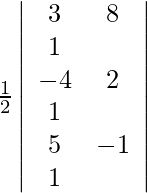
= ![]()
= ![]()
= ![]()
Therefore, area of the triangle is ![]() sq. units.
sq. units.
(ii)(2、7),(1、1)和(10、8)
解决方案:
Given (2, 7), (1, 1) and (10, 8) are the vertices of the triangle.
The area of the triangle is given by,
A = 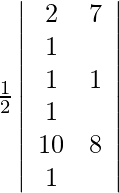
= ![]()
= ![]()
= ![]()
Therefore, area of the triangle is ![]() sq. units.
sq. units.
(iii)(-1,-8),(-2,-3)和(3、2)
解决方案:
Given (−1, −8), (−2, −3) and (3, 2) are the vertices of the triangle.
The area of the triangle is given by,
A = 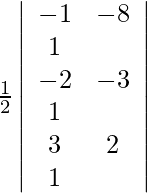
= ![]()
= ![]()
= ![]()
= 15
Therefore, area of the triangle is 15 sq. units.
(iv)(0,0),(6,0),(4,3)
解决方案:
Given (0, 0), (6, 0), (4, 3) are the vertices of the triangle.
The area of the triangle is given by,
A = 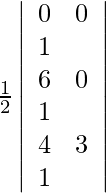
= ![]()
= ![]()
= 9
Therefore, area of the triangle is 9 sq. units.
问题2。使用行列式表明以下几点是共线的:
(i)(5、5),(− 5、1)和(10、7)
解决方案:
Given points are (5, 5), (−5, 1) and (10, 7).
For these points to be collinear, the area of the triangle they form must be zero. So, we get,
A = 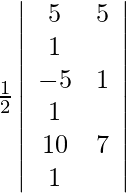
= ![]()
= ![]()
= 0
As the area of the triangle is 0, the points are collinear.
Hence proved.
(ii)(1,-1),(2,1)和(4,5)
解决方案:
Given points are (1, −1), (2, 1) and (10, 8).
For these points to be collinear, the area of the triangle they form must be zero. So, we get,
A = 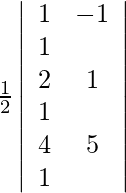
= ![]()
= ![]()
= 0
As the area of the triangle is 0, the points are collinear.
Hence proved.
(iii)(3,-2),(8,8)和(5,2)
解决方案:
Given points are (3, −2), (8, 8) and (5, 2).
For these points to be collinear, the area of the triangle they form must be zero. So, we get,
A = 
= ![]()
= ![]()
= 0
As the area of the triangle is 0, the points are collinear.
Hence proved.
(iv)(2、3),(-1,-2)和(5、8)
解决方案:
Given points are (2, 3), (−1, −2) and (5, 8).
For these points to be collinear, the area of the triangle they form must be zero. So, we get,
A = 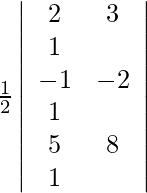
= ![]()
= ![]()
= 0
As the area of the triangle is 0, the points are collinear.
Hence proved.
问题3.如果点(a,0),(0,b)和(1,1)是共线的,则证明a + b = ab。
解决方案:
Given points (a, 0), (0, b) and (1, 1) are collinear.
For these points to be collinear, the area of the triangle they form must be zero. So, we get,
=> 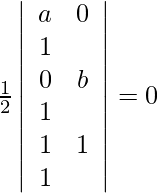
=> ![]()
=> ab − a − b = 0
=> a + b = ab
Hence proved.
问题4.使用行列式证明,如果ab’= a’b,则点(a,b),(a’,b’)和(a – a’,b – b)是共线的。
解决方案:
Given points are (a, b), (a’, b’) and (a – a’, b – b) and a b’ = a’ b.
For these points to be collinear, the area of the triangle they form must be zero. So, we get,
=> 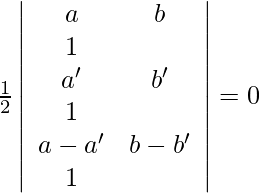
=> ![]()
=> ![]()
=> a b’ − a’ b = 0
=> a b’ = a’ b
Hence proved.
问题5.找到λ的值,以使点(1,-5),(− 4,5)和(λ,7)共线。
解决方案:
Given points are (1, −5), (−4, 5) and (λ, 7).
For these points to be collinear, the area of the triangle they form must be zero. So, we get,
=> 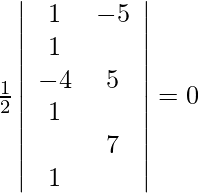
=> ![]()
=> −2 − 20 − 5λ − 28 − 5λ = 0
=> 10λ = 50
=> λ = 5
Therefore, the value of λ is 5.
问题6.如果∆的面积为35平方厘米,且顶点分别为(x,4),(2,-6)和( 5,4),则求x的值。
解决方案:
Given points are (x, 4), (2, −6) and (5, 4).
We know that, if vertices of a triangle are (x1, y1), (x2, y2) and (x3, y3), then the area of the triangle is given by,
A = 
=> 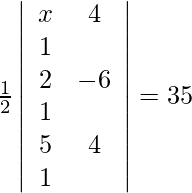
=> 
=> − 10x + 12 + 38 = ±70
=> – 10x + 50 = ±70
Taking positive sign, we get
=> – 10x + 50 = 70
=> 10x = – 20
=> x = – 2
Taking negative sign, we get
=> – 10x + 50 = – 70
=> 10x = 120
=> x = 12
Therefore, the value of x is 12 or –2.
问题7.使用行列式,找到顶点为(1、4),(2、3),(– 5,–3)的三角形的面积。给定的点是共线的吗?
解决方案:
Given points are (1, 4), (2, 3), (–5, –3).
So, area = 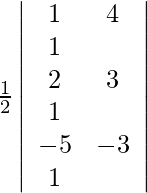
= ![]()
= ![]()
= ![]()
As the area of the triangle formed by these three points is not zero, the points are not collinear.
问题8.使用行列式,找到顶点为(–3,5),(3,–6),(7,2)的三角形的面积。
Given points are (–3, 5), (3, –6), (7, 2).
So, area = 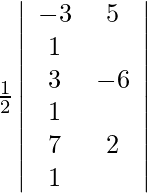
= ![]()
= ![]()
= ![]()
= 46
Therefore, the area of the triangle is 46 sq. units.
问题9。使用行列式求k的值,以使点(k,2–2k),(–k + 1,2k),(–4–k,6–2k)可以共线。
解决方案:
Given points are (k, 2–2k), (–k+1, 2k), (–4–k, 6–2k). As the points are collinear, the area must be 0.
=> 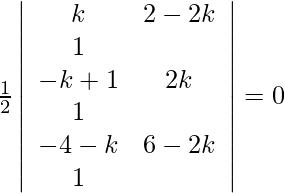
=> k(2k – 6 + 2k) – (2–2k) (–k + 1 + 4 + k) + [(1–k) (6–2k) – 2k (–4–k)] = 0
=> 8k2 + 4k – 4 = 0
=> 8k2 + 8k – 4k – 4 = 0
=> 8k (k+1) – 4 (k+1) = 0
=> 8k = 4 or k = –1
=> k = 1/2 or k = –1
Therefore, the value of k is 1/2 or –1.
问题10.如果点(x,–2),(5、2),(8、8)是共线的,则使用行列式求x。
解决方案:
Given points are (x, –2), (5, 2), (8, 8). As the points are collinear, the area must be 0.
=> 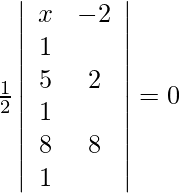
=> x(2 – 8) + 2(5 – 8) + 1(40–16) = 0
=> –6x – 6 + 24 = 0
=> 6x = 18
=> x = 3
Therefore, the value of x is 3.
问题11.如果点(3,–2),(x,2),(8,8)是共线的,请使用行列式求x。
解决方案:
Given points are (3, –2), (x, 2), (8, 8). As the points are collinear, the area must be 0.
=> 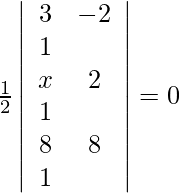
=> 3(2 – 8) + 2(x – 8) + 1(8x–16) = 0
=> –18 + 2x – 16 + 8x – 16 = 0
=> 10x = 50
=> x = 5
Therefore, the value of x is 5.
问题12:使用行列式,找到以下方程式
(i)连接点(1、2)和(3、6)的线。
解决方案:
Let (x, y), (1, 2), (3, 6) be the points on the line. As these points are collinear, we get,
=> 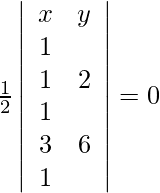
=> ![]()
=> −4x + 2y = 0
=> 2x − y = 0
Therefore, the required equation is 2x − y = 0.
(ii)连接点(3,1)和(9,3)的线。
解决方案:
Let (x, y), (3, 1), (9, 3) be the points on the line. As these points are collinear, we get,
=> 
=> ![]()
=> −2x + 6y = 0
=> x − 3y = 0
Therefore, the required equation is x − 3y = 0.
问题13.找到k的值
(i)如果顶点为(k,0)(4,0)(0,2)的三角形的面积为4平方单位。
解决方案:
Given points are (k, 0) (4, 0) (0, 2). According to the question, we have,
=> 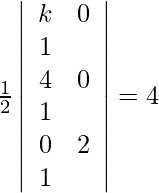
=> |k(0−2) − 0 + 1(8−0)| = 8
=> −2k + 8 = ±8
=> −2k + 8 = 8 or −2k + 8 = −8
=> k = 0 or k = 8
Therefore, the value of k is 0 or 8.
(ii)顶点为(−2,0)(0,4)(0,k)的三角形的面积是否为4平方单位。
解决方案:
Given points are (−2, 0) (0, 4) (0, k). According to the question, we have,
=> 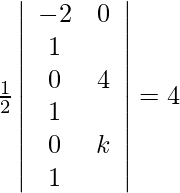
=> |−2(4−k) − 0 + 1(0)| = 8
=> −8 + 2k = ±8
=> −8 + 2k = 8 or −8 + 2k = −8
=> k = 8 or k = 0
Therefore, the value of k is 0 or 8.